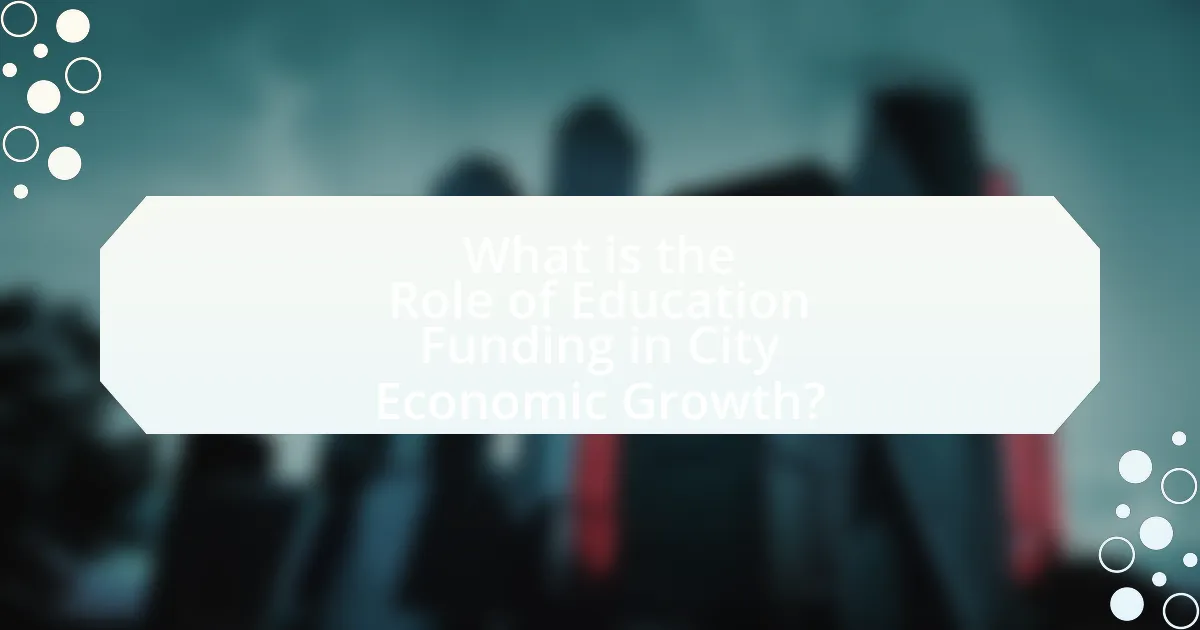Education funding is a critical factor in driving economic growth within cities by enhancing the quality of education, which subsequently improves workforce skills and productivity. The article examines how increased education funding leads to better educational outcomes, higher graduation rates, and ultimately, greater economic benefits for urban areas. It discusses the key components of education funding, its influence on local economies, workforce development, and social equity, while also addressing the challenges and disparities in funding allocation. Additionally, the article highlights best practices and innovative funding models that can optimize education funding for sustained economic growth.

What is the Role of Education Funding in City Economic Growth?
Education funding plays a crucial role in city economic growth by enhancing the quality of education, which in turn increases workforce skills and productivity. When cities invest in education, they create a more educated population capable of attracting businesses and fostering innovation. For instance, a study by the National Bureau of Economic Research found that increased funding for education leads to higher graduation rates and improved economic outcomes for individuals, contributing to overall economic development in urban areas. Additionally, cities with robust education systems often experience lower unemployment rates and higher income levels, further supporting economic growth.
How does education funding influence local economies?
Education funding significantly influences local economies by enhancing the quality of education, which in turn boosts workforce skills and productivity. Increased funding leads to better resources, facilities, and teacher salaries, resulting in improved student outcomes. For instance, a study by the National Bureau of Economic Research found that a 10% increase in per-pupil spending can lead to a 7% increase in future earnings for students, thereby contributing to higher local income levels. Additionally, well-funded educational institutions attract businesses seeking a skilled workforce, fostering economic development and job creation in the community.
What are the key components of education funding?
The key components of education funding include federal funding, state funding, local funding, grants, and private contributions. Federal funding typically comes from programs like Title I and special education funding, which aim to support disadvantaged schools and students. State funding is primarily allocated through formulas based on student enrollment and local property taxes, which can vary significantly across districts. Local funding often relies on property taxes, leading to disparities in resources available to schools. Grants from various organizations and foundations provide additional financial support for specific programs or initiatives. Private contributions, including donations from individuals and businesses, can also enhance educational resources and opportunities. These components collectively influence the quality and equity of education, impacting overall economic growth in cities.
How does education funding impact workforce development?
Education funding significantly impacts workforce development by ensuring that educational institutions can provide relevant training and resources aligned with labor market needs. Adequate funding allows schools and vocational programs to enhance curricula, invest in technology, and hire qualified instructors, which directly improves the skill sets of graduates. For instance, a report from the National Center for Education Statistics indicates that increased funding in community colleges leads to higher graduation rates and better job placement outcomes, thereby creating a more skilled workforce that meets the demands of local economies. This alignment between education and workforce needs fosters economic growth by reducing unemployment and increasing productivity in various sectors.
Why is education funding critical for urban development?
Education funding is critical for urban development because it directly influences workforce quality and economic growth. A well-funded education system enhances skill development, leading to a more competent labor force that attracts businesses and fosters innovation. For instance, cities with higher education investment, such as Boston, have seen significant economic returns, with studies indicating that every dollar spent on education can yield up to $10 in economic benefits. This correlation underscores the importance of education funding in creating sustainable urban environments and driving overall city prosperity.
What are the long-term effects of education funding on city growth?
Long-term effects of education funding on city growth include increased economic development, improved workforce quality, and enhanced social mobility. Education funding leads to better educational outcomes, which in turn fosters a more skilled labor force. For instance, a study by the National Bureau of Economic Research found that increased per-pupil spending in K-12 education correlates with higher future earnings for students, contributing to local economic growth. Additionally, cities that invest in education often experience lower crime rates and improved public health, further enhancing their attractiveness for businesses and residents. This creates a positive feedback loop where better education funding leads to sustained city growth over time.
How does education funding affect property values in cities?
Education funding positively affects property values in cities by enhancing the quality of local schools, which attracts families and increases demand for housing. Higher education funding typically leads to better educational outcomes, such as improved test scores and graduation rates, making neighborhoods with well-funded schools more desirable. For instance, a study by the National Bureau of Economic Research found that a 10% increase in school spending can raise property values by approximately 3% to 5%. This correlation indicates that as education funding improves school quality, property values rise due to increased demand from homebuyers seeking access to quality education for their children.
What challenges exist in education funding for cities?
Challenges in education funding for cities include inadequate financial resources, reliance on local property taxes, and disparities in funding allocation. Many urban areas face budget constraints that limit their ability to invest in quality education, leading to underfunded schools. The dependence on local property taxes creates inequities, as wealthier neighborhoods can generate more funding compared to lower-income areas, resulting in significant disparities in educational quality. According to the National Center for Education Statistics, schools in high-poverty areas receive about $1,000 less per student than those in low-poverty areas, highlighting the funding inequities that persist in urban education systems.
How do budget cuts impact educational institutions?
Budget cuts significantly reduce the financial resources available to educational institutions, leading to decreased program offerings, larger class sizes, and reduced staff. For instance, a study by the Center on Budget and Policy Priorities found that since the 2008 recession, many states have cut per-student funding, resulting in layoffs of teachers and support staff, which directly impacts student learning and educational outcomes. Furthermore, budget cuts often force schools to eliminate extracurricular activities and essential services, such as counseling and special education, which are crucial for student development and well-being. This reduction in funding can hinder the overall quality of education, ultimately affecting the economic growth of cities reliant on a well-educated workforce.
What are the disparities in education funding across different cities?
Disparities in education funding across different cities are significant, often influenced by local property taxes, state funding formulas, and socioeconomic factors. For instance, cities like San Francisco allocate over $20,000 per student, while others, such as Detroit, spend around $11,000 per student. This funding gap leads to unequal access to resources, experienced teachers, and advanced coursework, ultimately affecting student outcomes and economic opportunities. Research from the Education Trust highlights that schools in low-income areas receive about $1,000 less per student compared to those in wealthier neighborhoods, exacerbating educational inequities.
How can education funding be optimized for economic growth?
Education funding can be optimized for economic growth by reallocating resources towards high-impact programs that enhance workforce skills and align with local economic needs. Targeting funding towards vocational training, STEM education, and early childhood education has been shown to yield significant returns; for instance, a study by the Brookings Institution found that every dollar invested in early childhood education can generate up to $7 in economic returns through improved educational outcomes and reduced social costs. Additionally, implementing performance-based funding models that reward institutions for student outcomes can drive efficiency and accountability, ensuring that funds are directed towards initiatives that effectively contribute to economic development.
What strategies can cities implement to enhance education funding?
Cities can enhance education funding by diversifying revenue sources, such as implementing local taxes, seeking state and federal grants, and fostering public-private partnerships. For instance, cities like San Francisco have successfully utilized local parcel taxes to generate additional funding for schools, resulting in increased resources for educational programs. Furthermore, cities can engage in collaborative initiatives with businesses to create scholarship funds or internship programs, which not only provide financial support but also enhance workforce readiness. Research indicates that cities investing in education yield higher economic returns; for example, a study by the Brookings Institution found that every dollar invested in education can lead to a return of up to $4 in economic growth.

What are the Economic Benefits of Education Funding?
Education funding generates significant economic benefits by enhancing workforce skills and increasing productivity. A well-funded education system leads to higher graduation rates, which correlate with improved employment opportunities and higher wages. For instance, research from the National Bureau of Economic Research indicates that each additional year of schooling can increase an individual’s earnings by approximately 10%. Furthermore, education funding contributes to reduced crime rates and lower reliance on social services, which in turn decreases public spending. According to a study by the Brookings Institution, every dollar invested in education can yield up to $4 in economic returns through increased tax revenues and reduced costs associated with crime and health care. Thus, education funding not only equips individuals with essential skills but also fosters broader economic growth within communities.
How does education funding contribute to job creation?
Education funding contributes to job creation by enhancing the quality of education, which in turn equips students with the skills needed for the workforce. When educational institutions receive adequate funding, they can improve facilities, hire qualified teachers, and expand programs that align with market demands. For instance, a report from the National Bureau of Economic Research indicates that increased funding for education leads to higher graduation rates and better job prospects for graduates, ultimately resulting in a more skilled labor force. This skilled labor force attracts businesses, leading to job creation in various sectors.
What types of jobs are most influenced by education funding?
Jobs in education, healthcare, and skilled trades are most influenced by education funding. Education funding directly impacts the availability of resources, teacher salaries, and program development in schools, which in turn affects the quality of education and the workforce’s skill level. For instance, increased funding can lead to better-trained teachers and enhanced educational programs, resulting in a more skilled workforce in fields such as nursing and engineering. According to the National Center for Education Statistics, states that invest more in education tend to have higher graduation rates and better job prospects for graduates, demonstrating a clear link between education funding and job market outcomes.
How does a better-educated workforce attract businesses?
A better-educated workforce attracts businesses by providing a pool of skilled talent that enhances productivity and innovation. Companies seek locations where they can easily find employees with the necessary qualifications and expertise, which directly impacts their operational efficiency and competitiveness. For instance, a study by the Georgetown University Center on Education and the Workforce found that 65% of jobs in the U.S. will require postsecondary education by 2020, indicating a strong correlation between education levels and job availability. Furthermore, businesses benefit from lower training costs and higher employee retention rates in areas with a well-educated workforce, as these employees tend to adapt quickly and contribute effectively to organizational goals.
What role does education funding play in innovation and entrepreneurship?
Education funding plays a critical role in fostering innovation and entrepreneurship by providing the necessary resources for skill development, research, and access to technology. Increased funding enables educational institutions to enhance curricula, invest in state-of-the-art facilities, and support entrepreneurial programs, which in turn cultivates a skilled workforce capable of driving economic growth. For instance, a study by the National Bureau of Economic Research found that regions with higher education funding experience greater rates of startup formation and innovation, demonstrating a direct correlation between educational investment and entrepreneurial activity.
How does education funding support research and development?
Education funding supports research and development by providing essential financial resources for academic institutions to conduct innovative projects and studies. This funding enables universities and colleges to hire skilled researchers, purchase advanced equipment, and facilitate collaborative partnerships with industries. For instance, the National Science Foundation reported that federal funding for education-related research has led to significant advancements in technology and healthcare, contributing to economic growth. Additionally, education funding fosters an environment where students can engage in research activities, leading to the development of new ideas and solutions that drive local economies.
What are the connections between education funding and startup growth?
Education funding significantly influences startup growth by fostering a skilled workforce and promoting innovation. Increased investment in education leads to higher levels of educational attainment, which equips individuals with the necessary skills to contribute to and create startups. For instance, a report by the National Bureau of Economic Research indicates that regions with higher education funding experience a 20% increase in startup activity due to the availability of skilled labor. Additionally, educational institutions often serve as incubators for new ideas and technologies, further driving entrepreneurial ventures. Thus, the connection between education funding and startup growth is evident through the enhancement of human capital and the stimulation of innovation ecosystems.
How does education funding impact social equity in cities?
Education funding significantly impacts social equity in cities by determining the quality of educational resources available to students from different socioeconomic backgrounds. When funding is allocated equitably, it enables schools in low-income areas to access better facilities, experienced teachers, and advanced learning materials, which can lead to improved academic outcomes. For instance, a study by the National Center for Education Statistics found that schools in wealthier districts often receive funding that is three to four times higher than those in poorer districts, exacerbating educational disparities. This inequity in funding contributes to a cycle of poverty, as students from underfunded schools may struggle to achieve the same level of education and opportunities as their peers, ultimately affecting their future economic mobility and social equity within the city.
What are the effects of education funding on low-income communities?
Education funding significantly impacts low-income communities by enhancing educational resources, improving student outcomes, and fostering economic growth. Increased funding allows schools in these areas to hire qualified teachers, provide essential materials, and implement programs that cater to students’ diverse needs. For instance, research from the National Bureau of Economic Research indicates that a 10% increase in per-pupil spending can lead to a 7% increase in high school graduation rates and a 10% increase in college enrollment rates among low-income students. This correlation demonstrates that adequate funding not only improves educational attainment but also contributes to long-term economic benefits for the community, such as higher earning potential and reduced reliance on social services.
How does equitable education funding promote community development?
Equitable education funding promotes community development by ensuring that all students, regardless of their socioeconomic status, have access to quality educational resources. This access leads to improved educational outcomes, which in turn fosters a more skilled workforce. A skilled workforce attracts businesses and investments, driving economic growth within the community. For instance, research from the National Bureau of Economic Research indicates that increased funding for low-income schools correlates with higher graduation rates and better job prospects for graduates, ultimately benefiting local economies.

What are the Best Practices for Effective Education Funding?
The best practices for effective education funding include ensuring equitable distribution of resources, prioritizing evidence-based programs, and engaging stakeholders in the funding process. Equitable distribution addresses disparities in funding across different districts, which is crucial for providing all students with equal opportunities to succeed. Research from the Education Trust indicates that schools serving low-income students often receive significantly less funding than their wealthier counterparts, highlighting the need for policies that rectify these imbalances.
Prioritizing evidence-based programs ensures that funding is directed toward initiatives that have been proven to enhance student outcomes. For instance, studies from the Institute of Education Sciences show that investments in early childhood education yield substantial long-term benefits, including higher graduation rates and increased earnings.
Engaging stakeholders, including educators, parents, and community members, fosters transparency and accountability in the funding process. The National Education Association emphasizes that involving these groups in decision-making leads to more effective allocation of resources and better alignment with community needs. These practices collectively contribute to a more effective education funding system that supports economic growth in cities by developing a skilled workforce.
How can cities ensure transparency in education funding allocation?
Cities can ensure transparency in education funding allocation by implementing open data initiatives that allow stakeholders to access detailed financial information. This approach enables citizens, educators, and policymakers to track how funds are distributed and spent, fostering accountability. For instance, cities like San Francisco have adopted platforms that publish real-time budget data, which has been shown to increase public engagement and trust in local government. Additionally, regular audits and community forums can further enhance transparency by providing opportunities for public input and scrutiny, ensuring that funding decisions align with community needs and priorities.
What metrics should be used to evaluate education funding effectiveness?
To evaluate education funding effectiveness, metrics such as student achievement scores, graduation rates, and post-secondary enrollment rates should be utilized. Student achievement scores, often measured through standardized tests, provide direct insight into the academic performance of students, reflecting the impact of funding on educational quality. Graduation rates indicate the percentage of students who complete their education, serving as a critical measure of the system’s success in retaining students and preparing them for future opportunities. Post-secondary enrollment rates reveal how well the education system equips students for higher education, which is essential for economic growth. These metrics collectively demonstrate the correlation between education funding and educational outcomes, supporting the argument that effective funding leads to improved student performance and, consequently, economic development in cities.
How can community involvement enhance education funding decisions?
Community involvement can enhance education funding decisions by ensuring that funding allocations reflect the specific needs and priorities of local students and families. Engaging community members in discussions about educational needs leads to more targeted funding strategies, as evidenced by studies showing that schools with active parent and community engagement often receive more financial support and resources. For instance, a report from the National Education Association highlights that schools with strong community ties are more likely to secure grants and donations, which can significantly boost their funding. This alignment between community input and funding decisions fosters accountability and transparency, ultimately leading to improved educational outcomes and economic growth in the city.
What innovative funding models can cities adopt?
Cities can adopt innovative funding models such as public-private partnerships (PPPs), social impact bonds, and crowdfunding initiatives. Public-private partnerships allow cities to leverage private sector investment for public projects, enhancing infrastructure and services without solely relying on taxpayer funds. Social impact bonds enable cities to fund social programs through private investment, where returns are based on the achievement of specific outcomes, thus aligning financial incentives with community benefits. Crowdfunding initiatives empower residents to contribute directly to local projects, fostering community engagement and investment in education and economic growth. These models have been successfully implemented in various cities, demonstrating their effectiveness in driving economic growth through enhanced educational funding and resources.
How can public-private partnerships improve education funding?
Public-private partnerships can improve education funding by leveraging resources, expertise, and innovation from both sectors to enhance educational infrastructure and programs. These collaborations often result in increased financial investment, as private entities contribute capital and operational efficiencies that public institutions may lack. For instance, a study by the Brookings Institution found that partnerships can lead to significant improvements in school facilities and technology, which directly impact student outcomes. Additionally, these partnerships can facilitate access to specialized knowledge and skills, enabling schools to implement effective educational strategies that align with workforce needs, ultimately driving economic growth in cities.
What role do grants and donations play in education funding?
Grants and donations are crucial in education funding as they provide essential financial resources that support various educational initiatives and programs. These funds often supplement government budgets, enabling schools to enhance facilities, hire qualified staff, and implement innovative teaching methods. For instance, according to the National Center for Education Statistics, private donations and grants accounted for approximately 10% of total funding for public schools in the United States, highlighting their significant impact on educational quality and accessibility.
What are the key takeaways for maximizing education funding’s impact?
To maximize education funding’s impact, it is essential to prioritize targeted investments in high-need areas, ensure effective allocation of resources, and foster community engagement. Targeted investments, such as funding for STEM programs in underperforming schools, have been shown to improve student outcomes significantly. Effective allocation of resources involves data-driven decision-making, which can lead to a 20% increase in student performance, as evidenced by studies from the National Center for Education Statistics. Additionally, fostering community engagement through partnerships with local businesses and organizations can enhance educational opportunities and support, ultimately driving economic growth in cities.

Leave a Reply